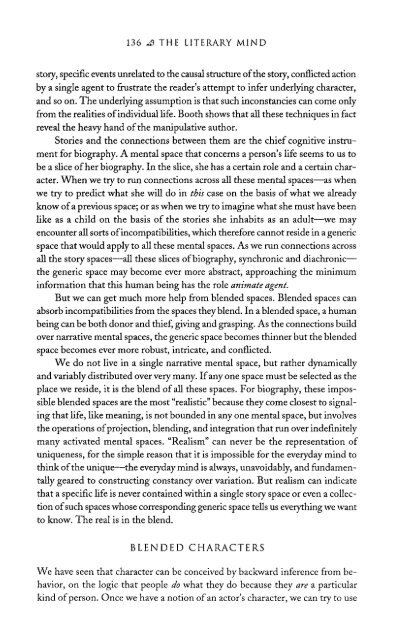The Literary Mind.pdf
The Literary Mind.pdf
The Literary Mind.pdf
You also want an ePaper? Increase the reach of your titles
YUMPU automatically turns print PDFs into web optimized ePapers that Google loves.
136 THE LITERARY MIND<br />
story, specific events unrelated to the causal structure of the story, conflicted action<br />
by a single agent to frustrate the reader's attempt to infer underlying character,<br />
and so on. <strong>The</strong> underlying assumption is that such inconstancies can come only<br />
from the realities of individual life. Booth shows that all these techniques in fact<br />
reveal the heavy hand of the manipulative author.<br />
Stories and the connections between them are the chief cognitive instrument<br />
for biography. A mental space that concerns a person's life seems to us to<br />
be a slice of her biography. In the slice, she has a certain role and a certain character.<br />
When we try to run connections across all these mental spaces—as when<br />
we try to predict what she will do in this case on the basis of what we already<br />
know of a previous space; or as when we try to imagine what she must have been<br />
like as a child on the basis of the stories she inhabits as an adult—we may<br />
encounter all sorts of incompatibilities, which therefore cannot reside in a generic<br />
space that would apply to all these mental spaces. As we run connections across<br />
all the story spaces—all these slices of biography, synchronic and diachronic—<br />
the generic space may become ever more abstract, approaching the minimum<br />
information that this human being has the role animate agent.<br />
But we can get much more help from blended spaces. Blended spaces can<br />
absorb incompatibilities from the spaces they blend. In a blended space, a human<br />
being can be both donor and thief, giving and grasping. As the connections build<br />
over narrative mental spaces, the generic space becomes thinner but the blended<br />
space becomes ever more robust, intricate, and conflicted.<br />
We do not live in a single narrative mental space, but rather dynamically<br />
and variably distributed over very many. If any one space must be selected as the<br />
place we reside, it is the blend of all these spaces. For biography, these impossible<br />
blended spaces are the most "realistic" because they come closest to signaling<br />
that life, like meaning, is not bounded in any one mental space, but involves<br />
the operations of projection, blending, and integration that run over indefinitely<br />
many activated mental spaces. "Realism" can never be the representation of<br />
uniqueness, for the simple reason that it is impossible for the everyday mind to<br />
think of the unique—the everyday mind is always, unavoidably, and fundamentally<br />
geared to constructing constancy over variation. But realism can indicate<br />
that a specific life is never contained within a single story space or even a collection<br />
of such spaces whose corresponding generic space tells us everything we want<br />
to know. <strong>The</strong> real is in the blend.<br />
BLENDED CHARACTERS<br />
We have seen that character can be conceived by backward inference from behavior,<br />
on the logic that people do what they do because they are a particular<br />
kind of person. Once we have a notion of an actor's character, we can try to use















